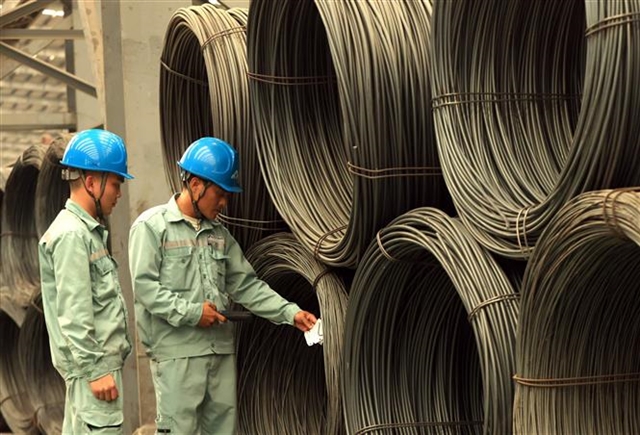 |
| Vietnam Steel Corporation’s steel products. The Ministry of Industry and Trade is developing and will be submitted to the Prime Minister shortly, the Việt Nam Steel Industry Development Strategy to 2030. — VNA/VNS Photo |
HÀ NỘI — The Ministry of Industry and Trade is developing and is expected to submit presently a Việt Nam Steel Industry Development Strategy to 2030, with a vision to 2050 – one of its efforts aimed at supporting the struggling steel industry.
It is expected to be submitted to the Prime Minister and the Government in September 2024.
To alleviate difficulties for the steel industry, the ministry has proposed that the Ministry of Finance review, update and adjust import tax policies for certain steel products with significant price fluctuations.
They have also proposed that the State Bank of Việt Nam direct and encourage commercial banks to implement preferential credit packages to support steel investment, production and business.
Additionally, on June 14, 2024, the Ministry issued Decision No. 1535/QĐ-BCT to investigate anti-dumping measures on steel products from China and South Korea. They also received a valid dossier for an anti-dumping investigation on HRC from India and China.
According to customs data, Việt Nam imported 886,000 tonnes of hot-rolled coil (HRC) in June, amounting to 151 per cent of domestic production. Imports from China accounted for 77 per cent. The import price of HRC from China was low, averaging US$560/tonne, $45-108/tonne less than other countries.
In 2023, Việt Nam’s steel production capacity was around 28 million tonnes per year, including 7-8 million tonnes of HRC and 14 million tonnes of construction steel, meeting domestic and some export needs.
The steel industry relies on 42 per cent scrap steel (mainly imported) and 58 per cent blast furnace production using iron ore. The domestic production of HRC is eight million tonnes per year, while the demand is 10 million tonnes, making the industry dependent on imports and vulnerable to price changes.
Most domestic enterprises produce basic steel products for real estate and lack high-quality products for the mechanical and manufacturing industries. The oversupply of domestic steel and increased imports intensify price competition. Additionally, global market instability and rising international shipping costs pose risks for the industry.
The Vietnam Steel Association (VSA) has urged the government to develop and enforce technical standards to prevent non-compliant steel imports. They also recommend support for steel export enterprises to handle foreign trade defense measures.
To strengthen the steel industry, the Ministry of Industry and Trade is finalising a draft to propose the Law on Key Industrial Development, aiming to develop the steel industry into a national foundation industry, meeting domestic needs and rapidly increasing exports. — VNS
- Reduce Hair Loss with PURA D’OR Gold Label Shampoo
- Castor Oil Has Made a “Huge” Difference With Hair and Brow Growth
- Excessive hair loss in men: Signs of illness that cannot be subjective
- Dịch Vụ SEO Website ở Los Angeles, CA: đưa trang web doanh nghiệp bạn lên top Google
- Nails Salon Sierra Madre
 VnExpress News The News Gateway of Vietnam
VnExpress News The News Gateway of Vietnam




